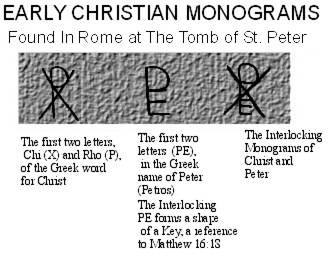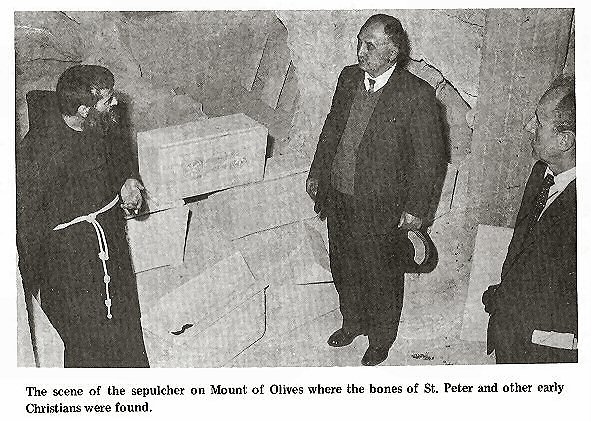Was Saint Peter buried in Rome or in Jerusalem?
[ Bible Probe ] [ FAQ ]Posted by bibleprobe on October 28, 2006 at 11:44:55:
[b]WAS THE APOSTLE PETER EVER IN ROME?[/b]
The archeological proof of the existence of St. Peters tomb under St. Peters basilica in Rome.
"Nero...publicly announcing himself as the first among God's chief enemies, he was led on to the slaughter of the apostles. It is, therefore, recorded that Paul was beheaded in Rome itself, and that Peter likewise was crucified under Nero. This account of Peter and Paul is substantiated by the fact that their names are preserved in the cemeteries of that place even to the present day. It is confirmed likewise by Caius, a member of the Church, who arose under Zephyrinus, bishop of Rome [about 200 AD.]. He, in a published disputation with Proclus, the leader of the Phrygian heresy, speaks as follows concerning the places where the sacred corpses of the aforesaid apostles are laid: "But I can show the trophies of the apostles. For if you will go to the Vatican or to the Ostian way, you will find the trophies of those who laid the foundations of this church." And that they both suffered martyrdom at the same time is stated by Dionysius, bishop of Corinth, in his epistle to the Romans, in the following words: "You have thus by such an admonition bound together the planting of Peter and of Paul at Rome and Corinth." [Eusebius, [A.D. 303] (Church History 2:25:5-8)]
On Wednesday 26th June 1968, Pope Paul VI, conducting an audience in the basilica of Saint Peter in Rome, departed from his normal routine to issue a statement of enormous significance to the Holy See, Roman Catholics and Christians throughout the world: the Pope declared that the mortal remains of Peter, foremost of the Apostles of Jesus Christ, had been found beneath the great church in which he was speaking. The statement marked the culmination of one of the most famous and important archaeological investigations of recent times; a vast undertaking which had engaged the talents of scientists, historians and linguists for a quarter of a century.
[b]THE SEARCH FOR THE BONES OF SAINT PETER ON THE VATICAN HILL[/b]:
Among the more than 30,000 Greek and Latin inscriptions have been discovered in the catacombs of Rome, is this marble slab above is from about the year 313 A.D. The slab sealed the tomb of a little boy named Asellus and the inscription goes on to tell us that he had lived 5 years, 8 months and 23 days. To the left we see the images of the Saints Peter and Paul, with the monogram of Christ above the name of Peter. The fact that the Gospel of Jesus brought to Rome by St. Peter and St. Paul was clearly professed by the early Christian community there.
[i]The Archaeologists found the early Christian Monogram used for the name of St. Peter over two dozen times, on and around the tomb of the Apostle.[/i]
But when Kirschbaum looked more carefully inside the cavity, he noticed that right at one end, where the grave stretched underneath the Red Wall, there was a small pile of bones. The Vatican excavators summoned the Pope immediately and shortly after the closing of the basilica Pius XII seated himself on a stool beside the cavity and watched Englebert Kirschbaum slowly hand out the fragments of bone to his colleagues. Most of the fragments were small but some were larger. Part of a breastbone was handed out, and then half of a shoulder blade. There was no skull. This absence of the remains of Peter's head did not disturb Pius XII or the excavators, on the contrary, it actually confirmed one of the great traditions of the medieval church. All those present, the Pope and the excavators, knew that a skull in the basilica of Saint John Lateran since at least the ninth century, was widely believed to be that of Peter. Obviously, the skull had been taken from this grave at some stage in the early medieval period to adorn the parish church of the Pope himself. 
Dr Galeazzi-Lisi reported back on the remains discovered beneath the aedicula. They were the bones of a powerfully built man who had been 65 or 70 years of age at the time of his death. But it is a tribute to the professionalism of the excavators and the caution of Pius XII himself that the Pope reported the discoveries to the world in the following terms in his Christmas broadcast on 23rd of December 1950:
Has the tomb of Saint Peter really been found? To that question the answer is beyond all doubt yes. The tomb of the Prince of the Apostles has been found. Such is the final conclusion after all the labor and study of these years. A second question, subordinate to the first, refers to the relics of Saint Peter. Have they been found? At the side of the tomb remains of human bones have been discovered. However, it is impossible to prove with certainty that they belong to the apostle. This still leaves intact the historical reality of the tomb itself.
[b]Read more about this archeological search in Rome:http://www.catholicapologetics.net/apolo_74
------------------------------
[b]NOW FOR THE JERUSALEM CONNECTION:[/b]
Was Peter's real tomb discovered in Jerusalem in 1953?
The Catholic Church says that Peter was Pope in Rome from 41 to 66 A.D., a period of twenty-five years, but the Bible shows a different story. The book of the Acts of the Apostles (in either the Catholic or Protestant Bible) records the following: 
In Jerusalem the writer spoke to many Franciscan priests who all read, finally, though reluctantly, that the bones of Simon Bar Jona (St. Peter) were found in Jerusalem, on the Franciscan monastery site called, "Dominus Flevit" (where Jesus was supposed to have wept over Jerusalem), on the Mount of Olives. The pictures show the story. The first show an excavation where the names of Christian Biblical characters were found on the ossuaries (bone boxes). The names of Mary and Martha were found on one box and right next to it was one with the name of Lazarus, their brother. Other names of early Christians were found on other boxes. Of greatest interest, however, was that which was found within twelve feet from the place where the remains of Mary, Martha and Lazarus were found—the remains of St. Peter. They were found in an ossuary, on the outside of which was clearly and beautifully written in Aramaic, "Simon Bar Jona".
Peter was preaching the Gospel to the circumcision (the Jews) in Caesarea and Joppa in Palestine, ministering unto the household of Cornelius, which is a distance of 1,800 miles from Rome (Acts 10:23, 24). Soon after, about the year 44 A.D. (Acts 12), Peter was cast into prison in Jerusalem by Herod, but he was released by an angel. From 46 to 52 A.D., we read in the 13th chapter that he was in Jerusalem preaching the difference between Law and Grace. Saul was converted in 34 A.D. and became Paul the Apostle (Acts 9). Paul tells us that three years after his conversion in 37 A.D., he "went up to Jerusalem to see Peter" (Galatians 1:18), and in 51 A.D., fourteen years later, he again went up to Jerusalem (Gal. 2:1, 8), Peter being mentioned. Soon after that he met Peter in Antioch, and as Paul says, "Withstood him to the face, because he was to be blamed," Gal. 2:11. The evidence is abundant, the truth is clear from the Scriptures which have never failed. It would be breathtaking to read of the boldness of Paul in dealing with Peter. Very few, if any, have withstood a Pope and lived (except in these days when everybody seems to withstand him). If Peter were Pope it would have been no different. Paul does not only withstand Peter but rebukes him and blames him of being at fault.
When Pope Pius XII declared the Assumption of Mary to be an article of faith in 1950, the Catholic Church in Jerusalem then quickly sold the tomb of Mary to the Armenian Church. Ex-priest Lavallo told me personally that there is another tomb of St. Mary in Ephesus. But the tomb of St. Peter is altogether different for they would rather that it never existed, and to buy or sell such a site would be out of the question. It fell upon them in this manner, as I was told by a Franciscan monk of the monastery of "Dominus Flevit". One of their members was spading the ground on this site in 1953, when his shovel fell through. Excavation was started and there, a large underground Christian burial ground was uncovered. The initial of Christ in Greek was written there which would never have been found in a Jewish, Arab or pagan cemetery. By the structure of the writings, it was established by scientists that they were of the days just before the destruction of Jerusalem by Titus in 70 A.D. On the ossuaries were found many names of the Christian of the early Church. It was prophesied in the Bible that Jesus would stand on the Mount of Olives at His return to earth. You can see then, how the Christians would be inclined to have their burial ground on the Mount, for here also, had been a favorite meeting place of Jesus and His disciples. In all the cemetery, nothing was found (as also in the Catacombs in Rome) which resemble Arab, Jewish, Catholic or pagan practices. Dr. Glueck, being Jewish, is not fully aware, no doubt, that such a discovery is very embarrassing since it undermines the very foundation of the Roman Catholic Church. Since Peter did not live in Rome and therefore was not martyred or buried there, it naturally follows that he was not their first Pope.
[b]Read more about this archeological search in Jerusalem:[/b]
http://www.aloha.net/~mikesch/peters-jerusalem-tomb.htm]HERE
This board is not in use